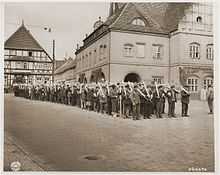Gardelegen
| Gardelegen | ||
|---|---|---|
 | ||
| ||
 Gardelegen | ||
Location of Gardelegen within Altmarkkreis Salzwedel district  | ||
| Coordinates: 52°31′35″N 11°23′33″E / 52.52639°N 11.39250°ECoordinates: 52°31′35″N 11°23′33″E / 52.52639°N 11.39250°E | ||
| Country | Germany | |
| State | Saxony-Anhalt | |
| District | Altmarkkreis Salzwedel | |
| Government | ||
| • Mayor | Konrad Fuchs (SPD) | |
| Area | ||
| • Total | 632.24 km2 (244.11 sq mi) | |
| Elevation | 43 m (141 ft) | |
| Population (2012-12-31)[1] | ||
| • Total | 23,237 | |
| • Density | 37/km2 (95/sq mi) | |
| Time zone | CET/CEST (UTC+1/+2) | |
| Postal codes | 39638 | |
| Dialling codes | 03907, 039056, 039085, 039087, 039088 | |
| Vehicle registration | SAW | |
| Website | www.gardelegen.info | |
Gardelegen (German pronunciation: [ˈɡaʁdəleːɡən]) is a town in Saxony-Anhalt, Germany. It is situated on the right bank of the Milde, 20 m. W. from Stendal, on the main line of railway Berlin-Hanover.
History

It has a Roman Catholic and three Evangelical churches, a hospital, founded in 1285, and a high-grade school. There are considerable manufactures, notably agricultural machinery and buttons, and its beer has a great repute. Gardelegen was founded in the 10th century (first named 1196), and was for a long time the seat of a line of counts. In 1358 Gardelegen became a city of the Hanse. It suffered considerably in the Thirty Years' War, and in 1775 was burned by the French. On the neighboring heath Margrave Louis I. of Brandenburg gained, in 1343, a victory over Otto the Mild of Brunswick.
On 13 April 1945, 1016 concentration camp prisoners were burned alive by the Germans in the Isenschnibbler Feldscheune. Today this area is the site of a memorial for the dead.
At the height of the cold war, a USAF RB-66 reconnaissance aircraft was shot down by Soviet fighters near the town on 10 March 1964. Her crew bailed out and was rescued and eventually handed back to West-Berlin by Soviet forces.[2]
After having incorporated 18 neighboring towns and villages in 2011, Gardelegen is now Germany's third largest city by area, trailing only Berlin and Hamburg.
International relations
Gardelegen is twinned with:
-
 Waltrop, Northrhine-Westphalia, Germany
Waltrop, Northrhine-Westphalia, Germany -
 Gifhorn, Lower-Saxony, Germany
Gifhorn, Lower-Saxony, Germany -
 Darłowo, Poland
Darłowo, Poland -
 Dumfries, United Kingdom
Dumfries, United Kingdom
References
- ↑ "Bevölkerung der Gemeinden 31.12.2012". Statistisches Landesamt Sachsen-Anhalt (in German). January 2014.
- ↑ Dejá vu in Gardelegen by Wolfgang Preisler
External links
![]() This article incorporates text from a publication now in the public domain: Chisholm, Hugh, ed. (1911). Encyclopædia Britannica (11th ed.). Cambridge University Press
This article incorporates text from a publication now in the public domain: Chisholm, Hugh, ed. (1911). Encyclopædia Britannica (11th ed.). Cambridge University Press
| Wikimedia Commons has media related to Gardelegen. |
| |||||||
